If you harvest your own fruit-any kind of fruit-you know how many leftover skins, seeds, pits, cooked stuff, raw stuff, and other things are leftover from processing. So much scrap, from so much good fruit. If you're anything like me, you may have wondered if there's anything you can do with it. There is: fruit scrap vinegar.
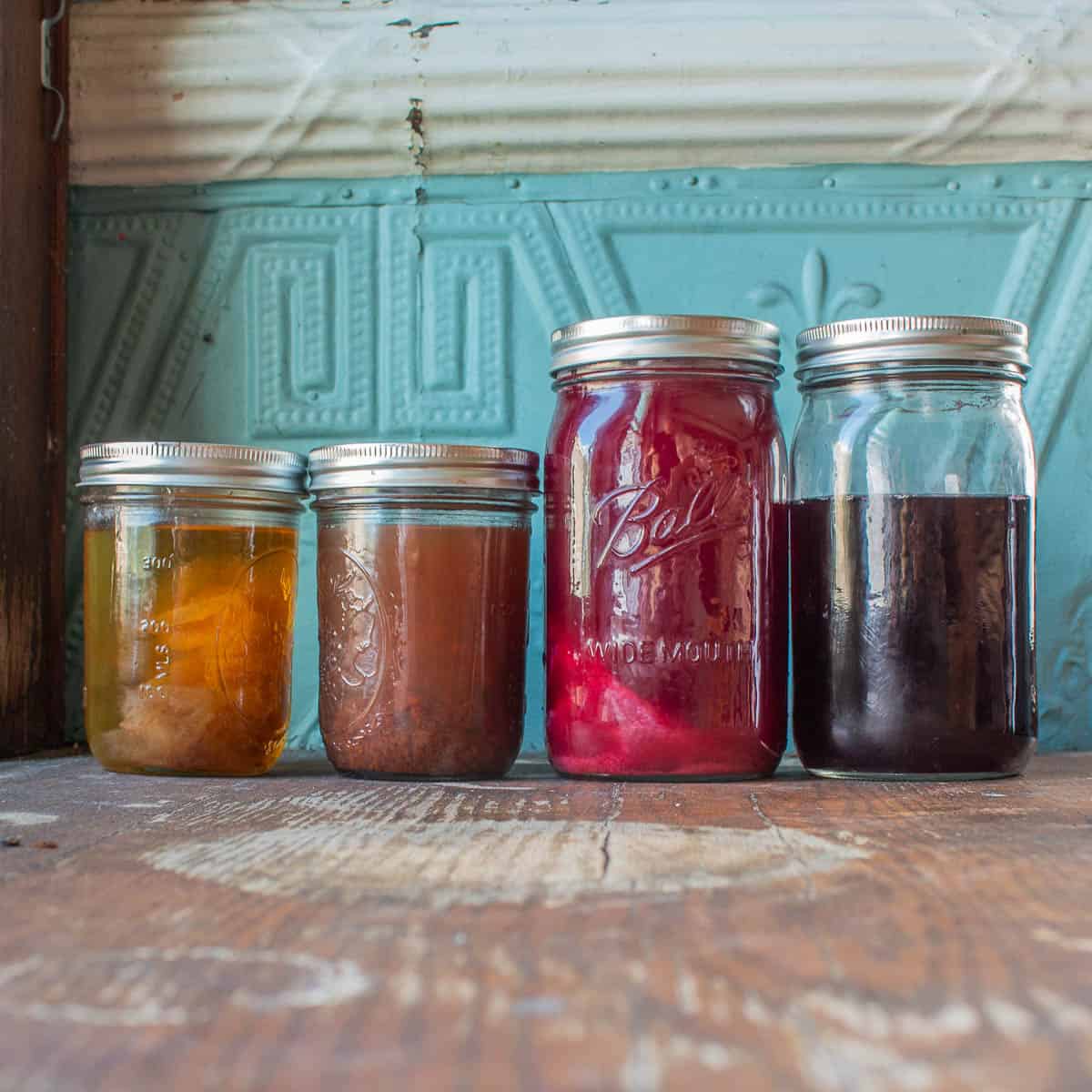
I first started messing around with fruit scraps in nice restaurants I worked in where we would have all kinds of amazing fruit come in. After the processing, sometimes there would be things leftover, pits, skins, seeds--things I knew had really delicious solutes still hanging out in them, but I didn't know what to do with.
The first thing I started doing was infusing vinegar with spent grape pits and seeds--and it was shocking. The flavor was concentrated, pure and delicious. If you want to know more about that, see my post on fruit-infused vinegar here--it's a great way to use fruit, especially berries.
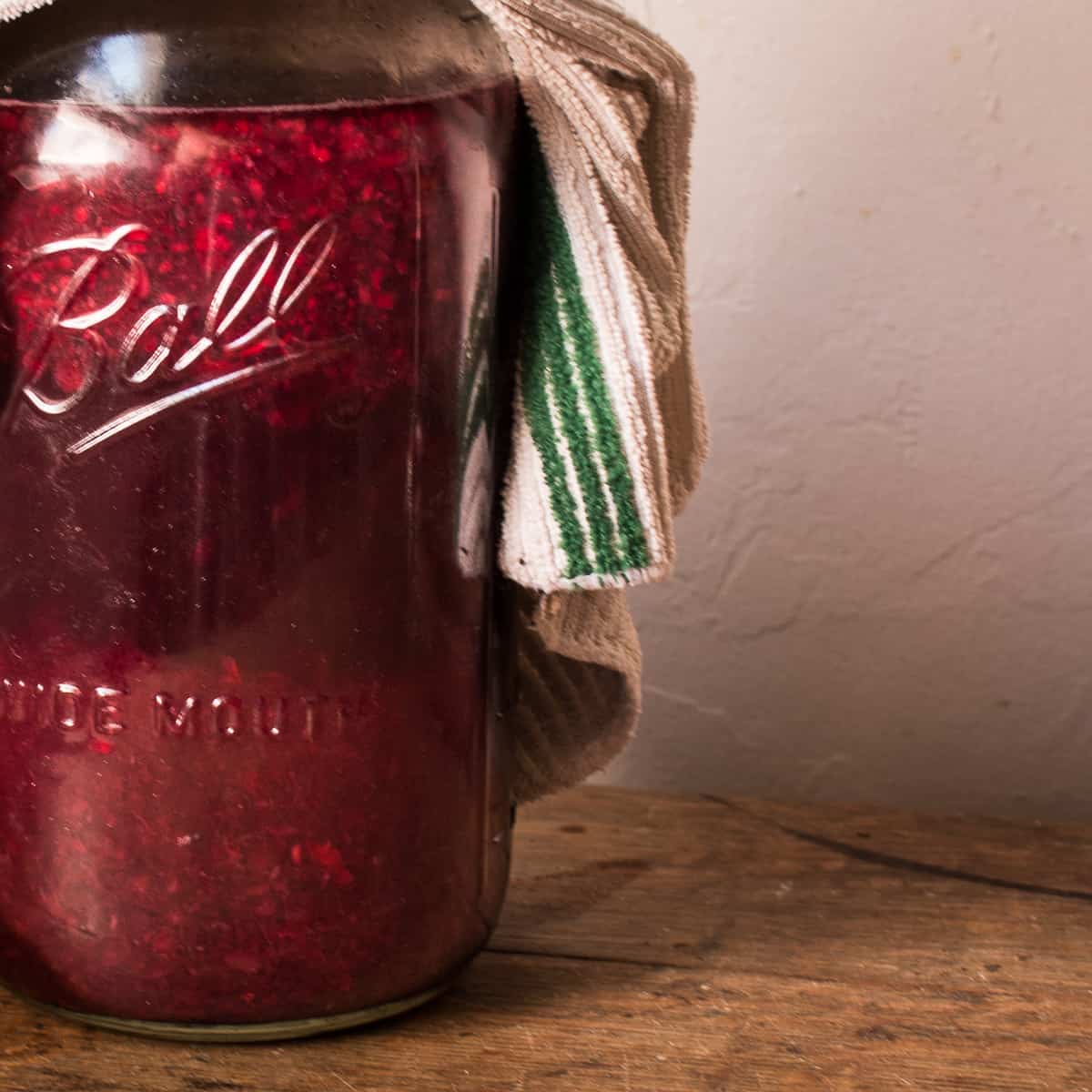
Step by Step
This is the older, more mature cousin to the infusion recipe. This is an easy, naturally fermented vinegar made from skins, seeds, pits, pulp, and just about anything else you can throw at it. I've made it with frozen fruit, dried, rehydrated fruit, fruit juice and skins. The images below describe the process.
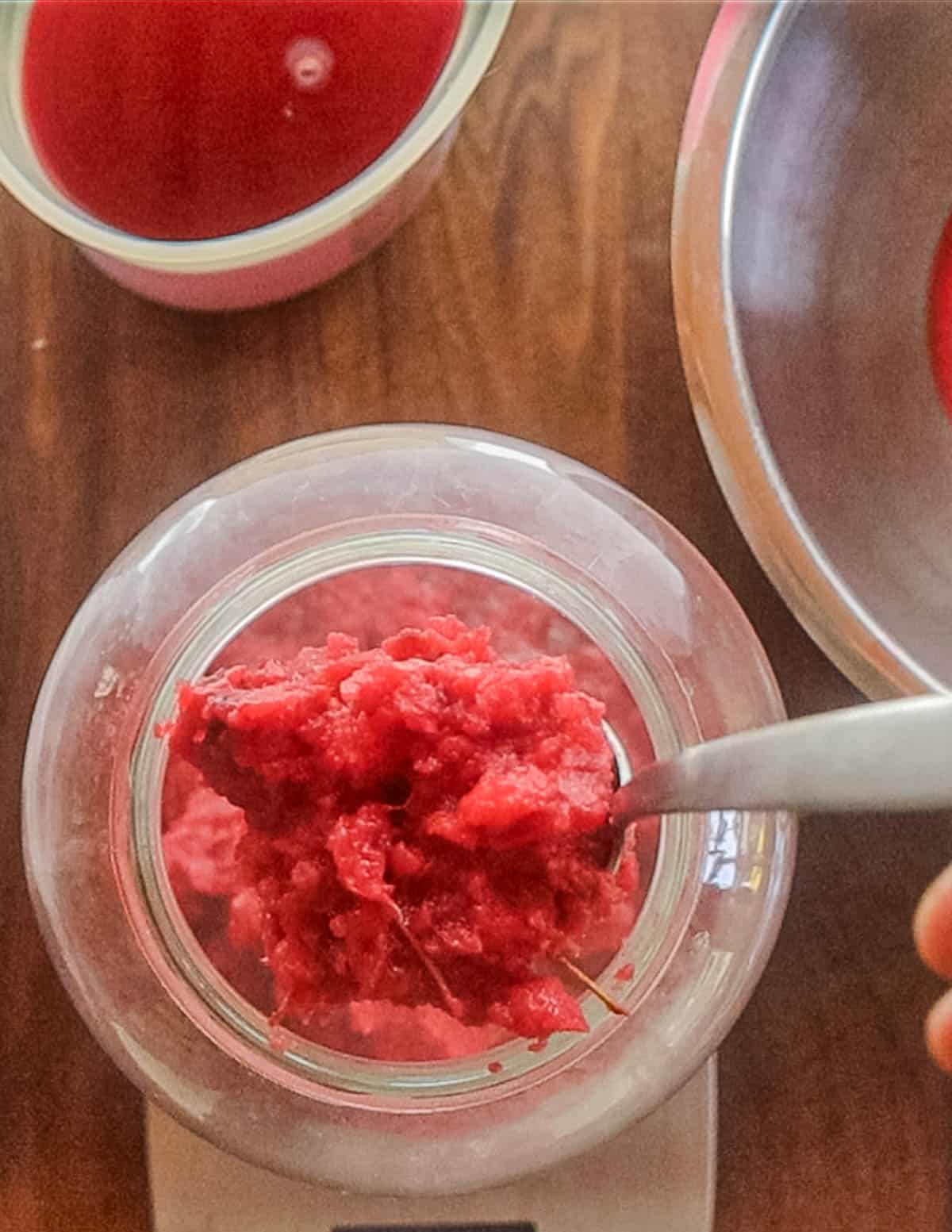
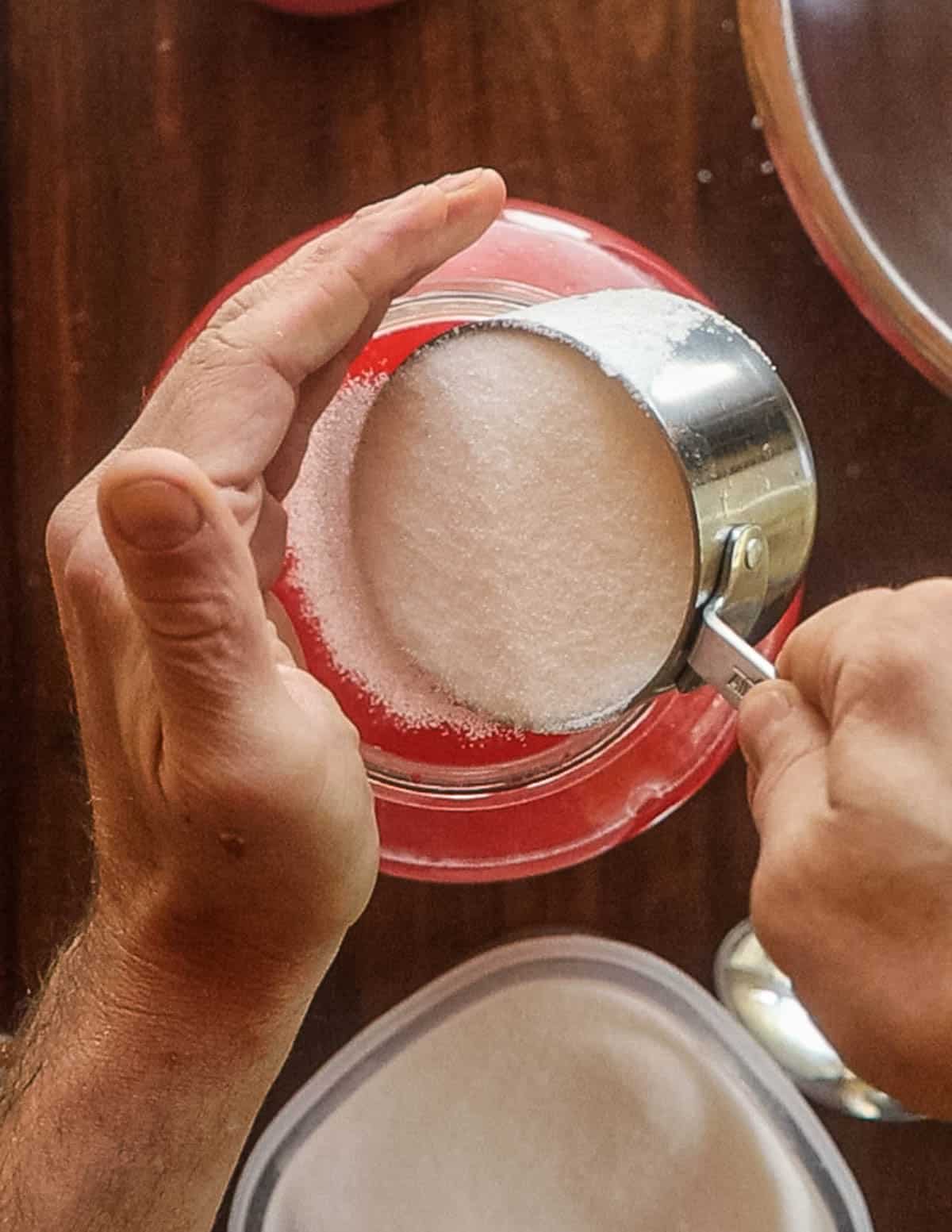
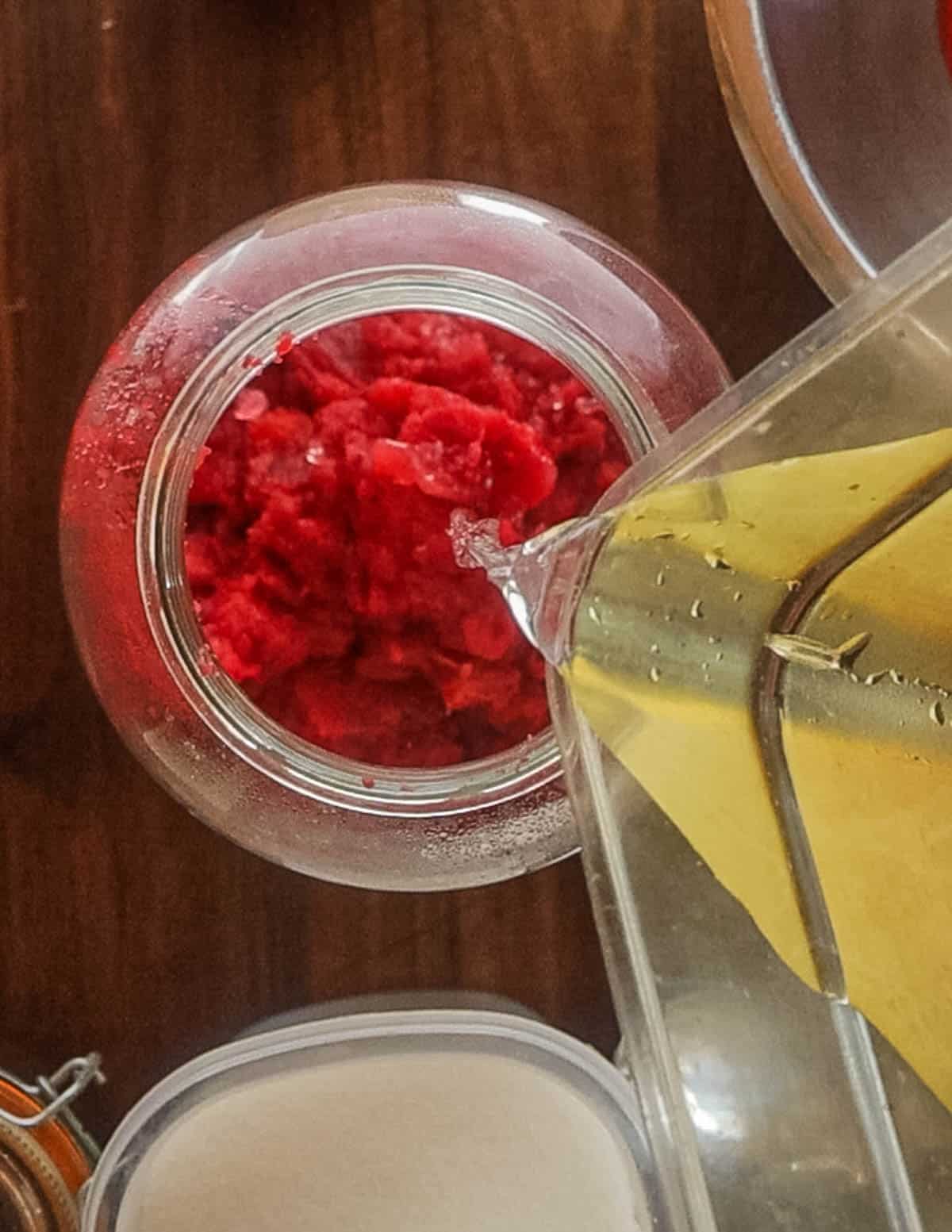
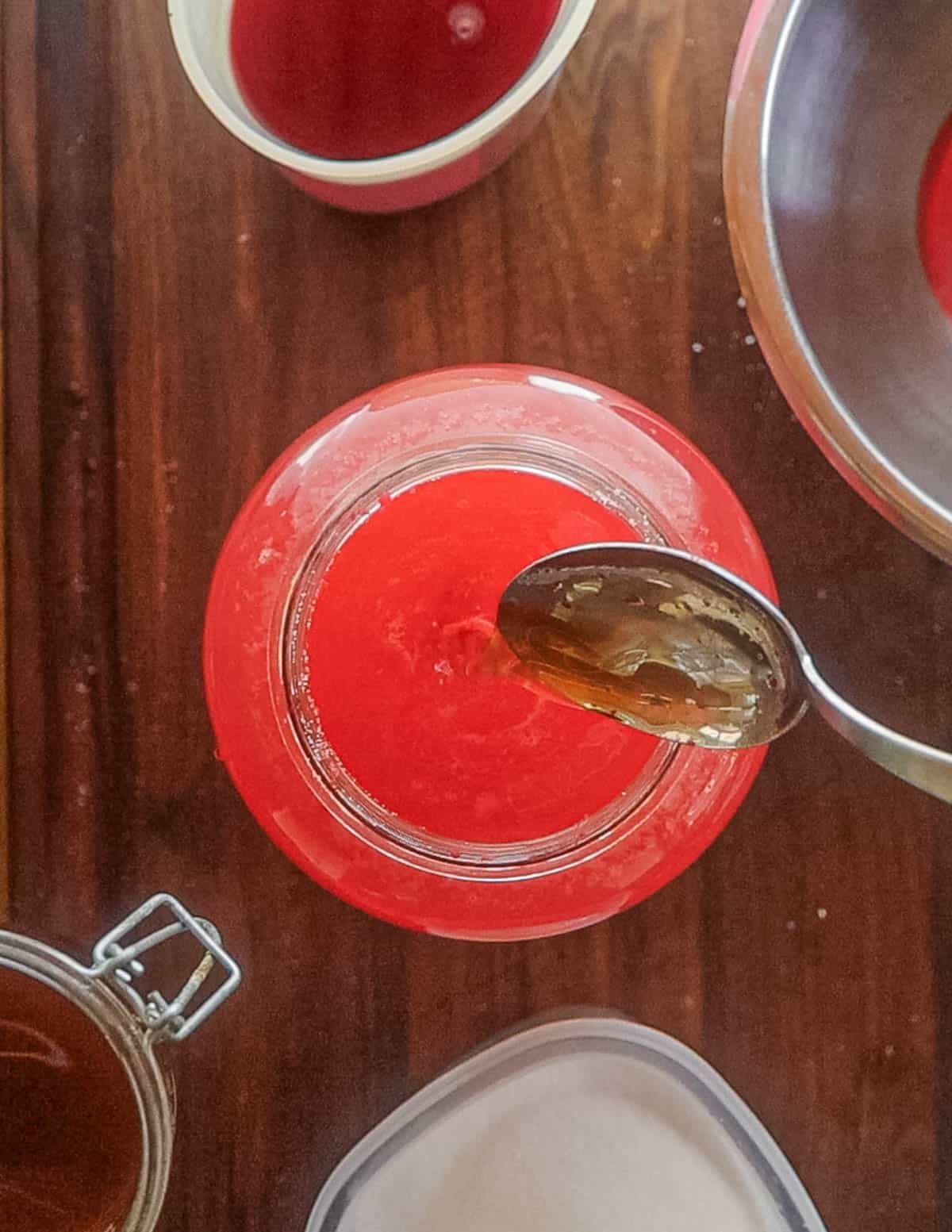
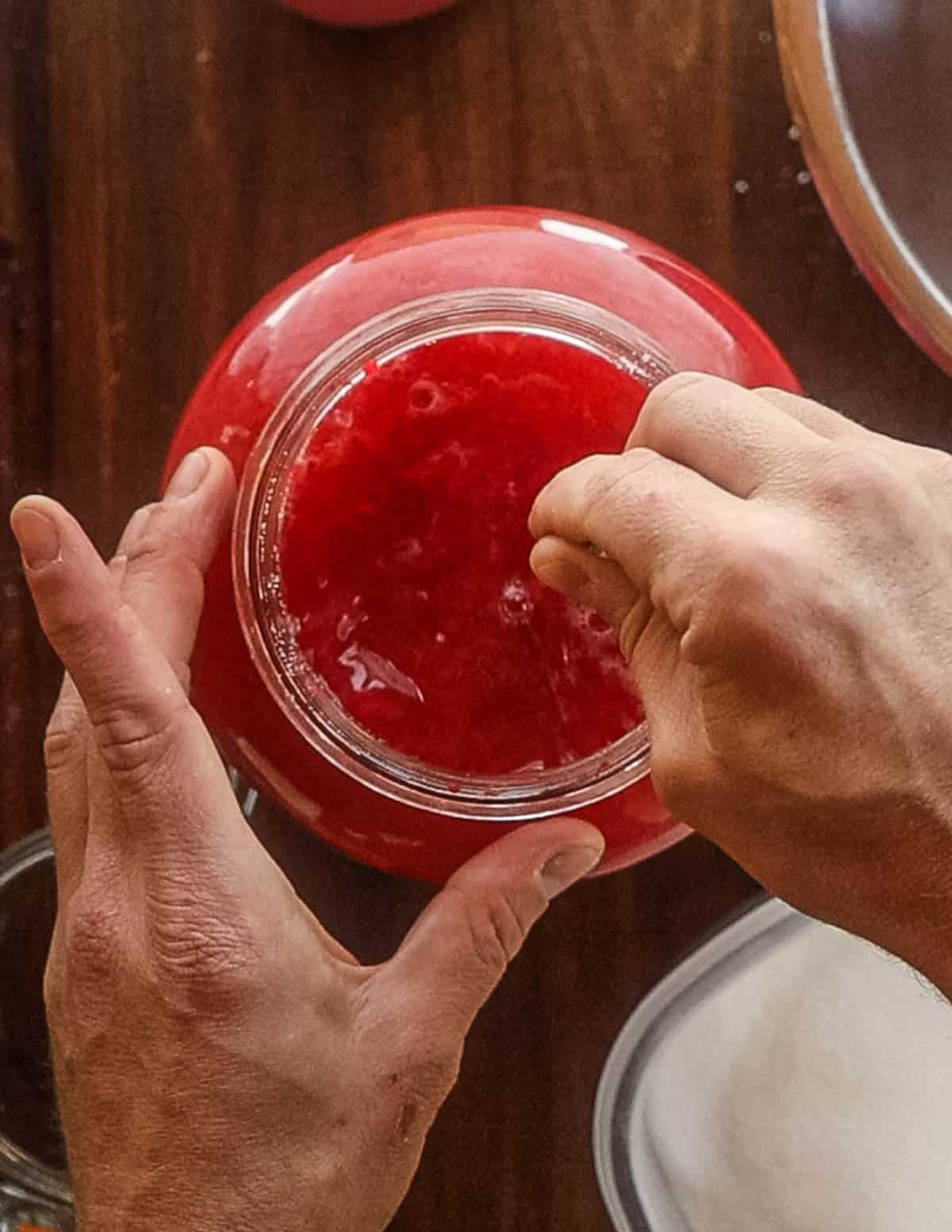
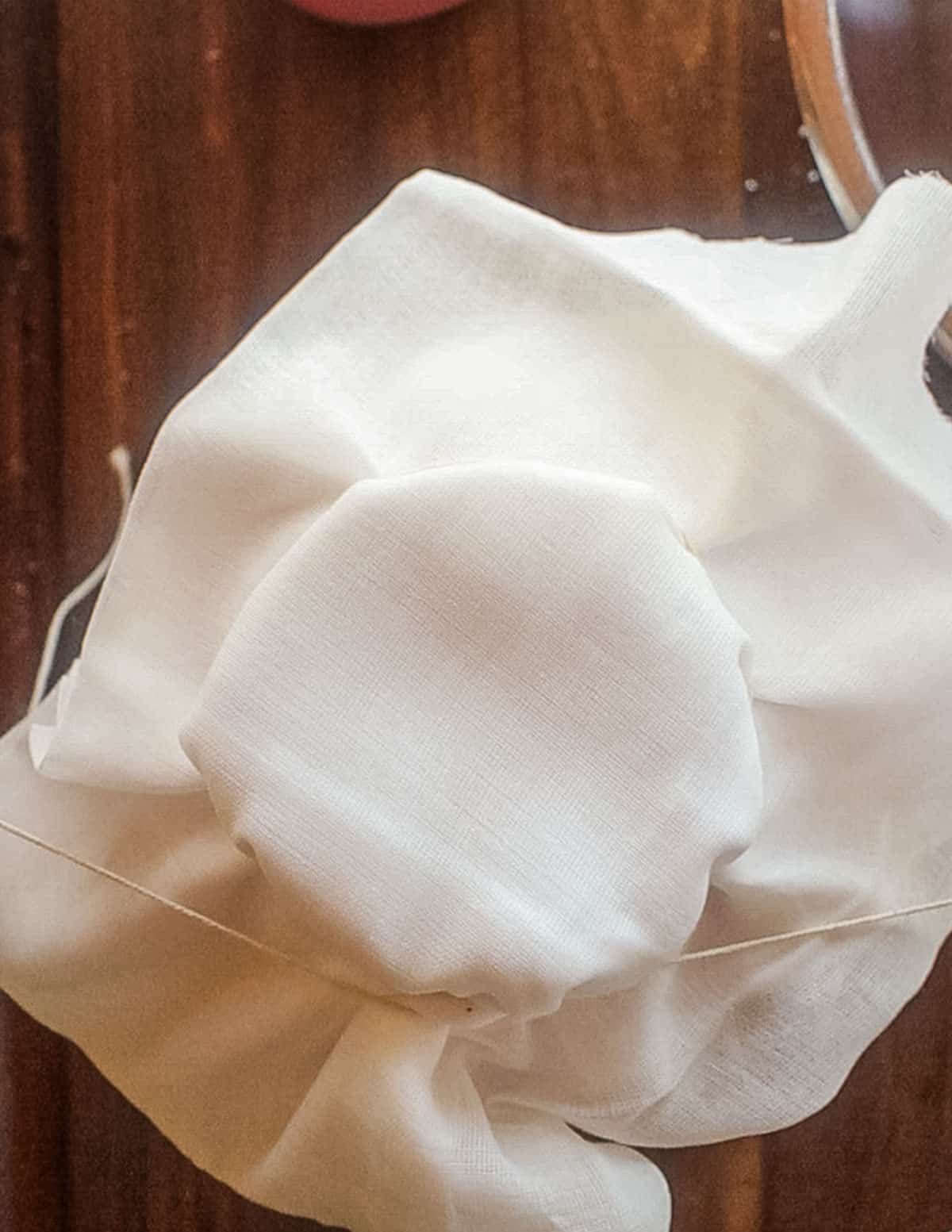
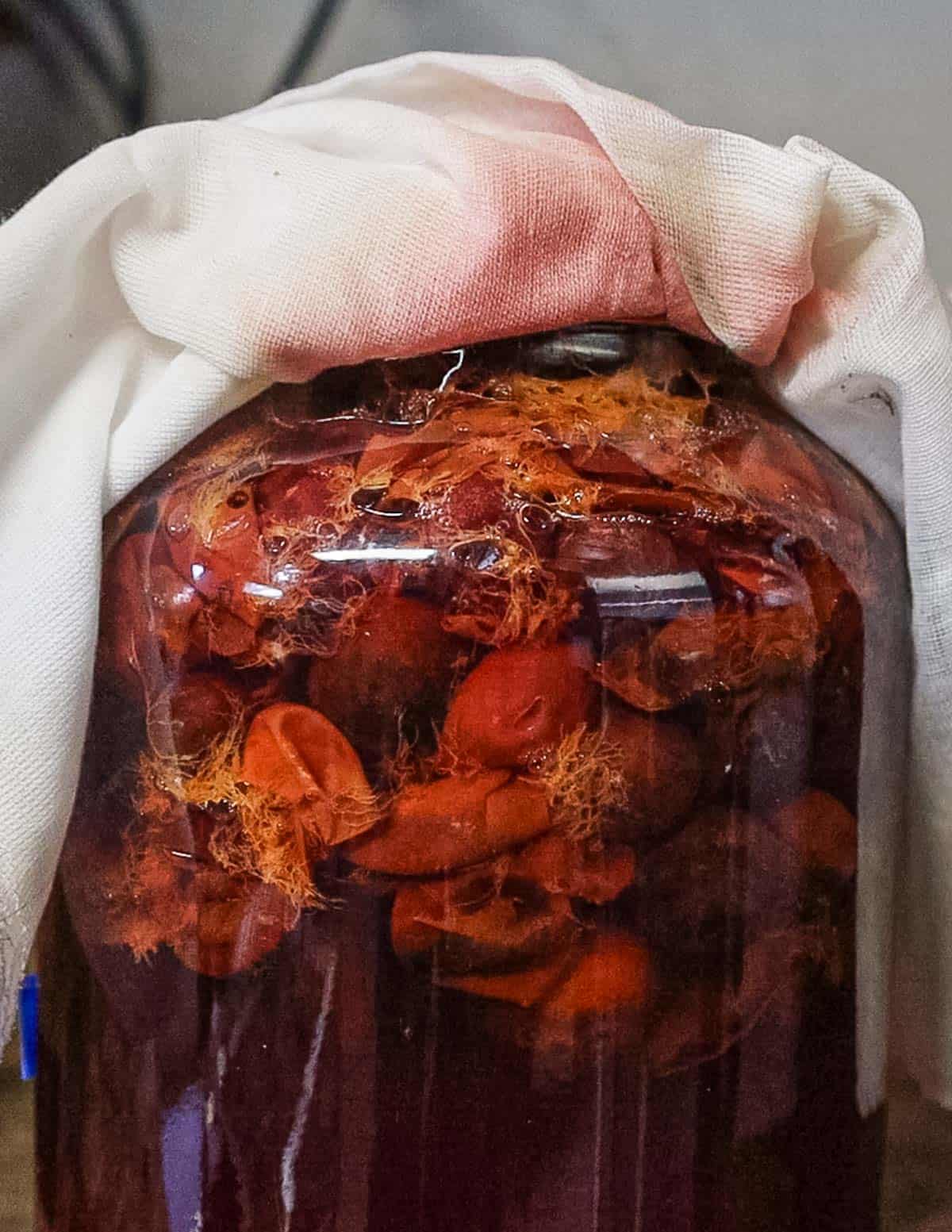
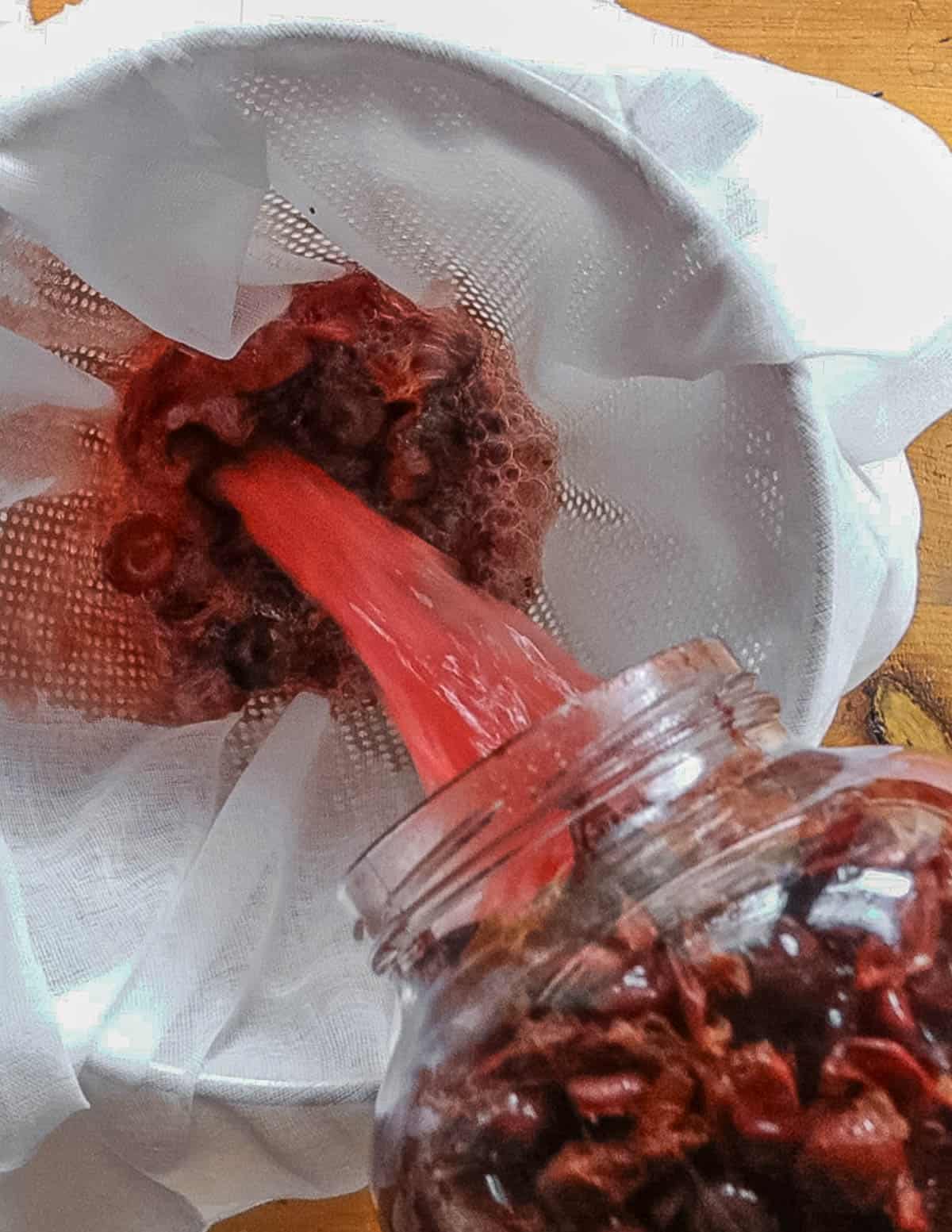
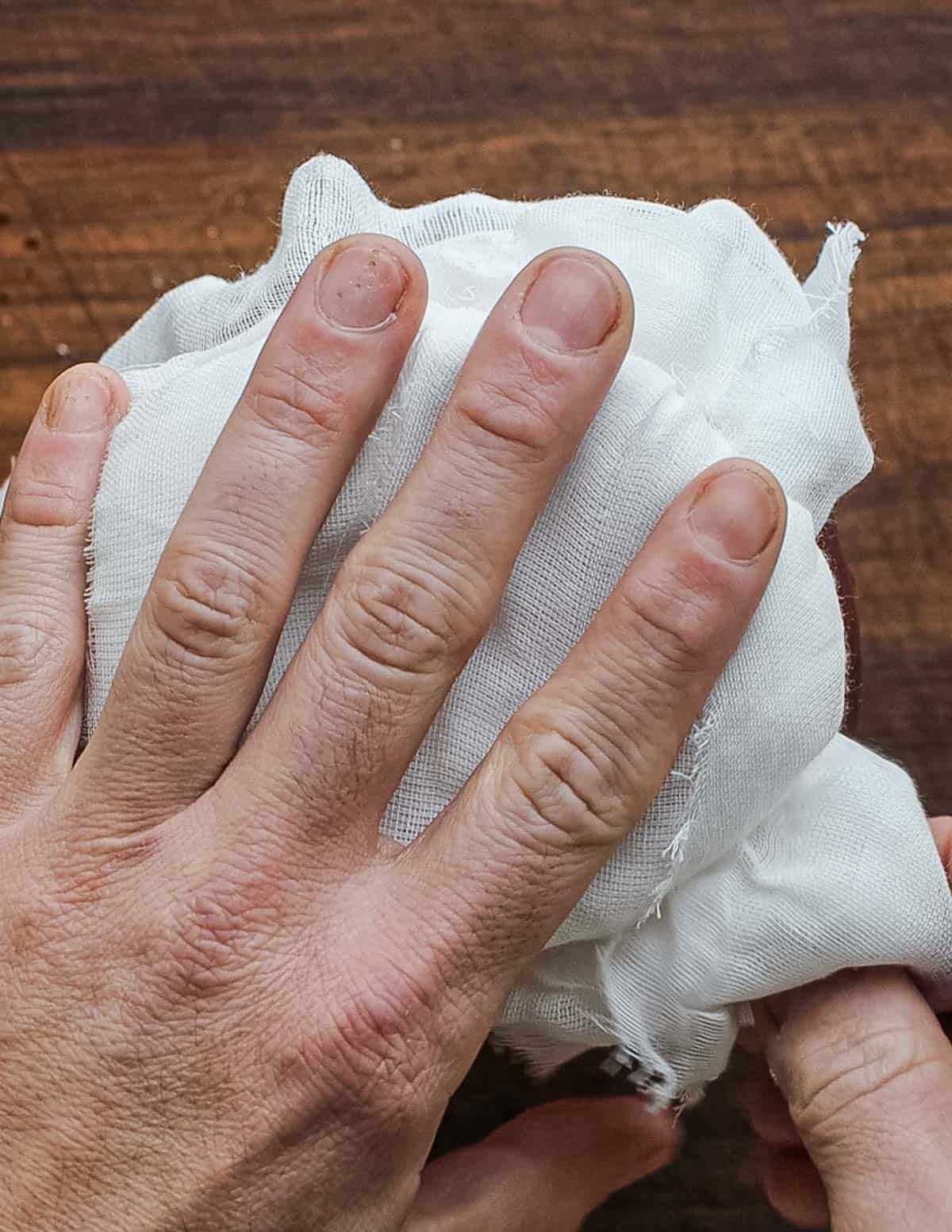
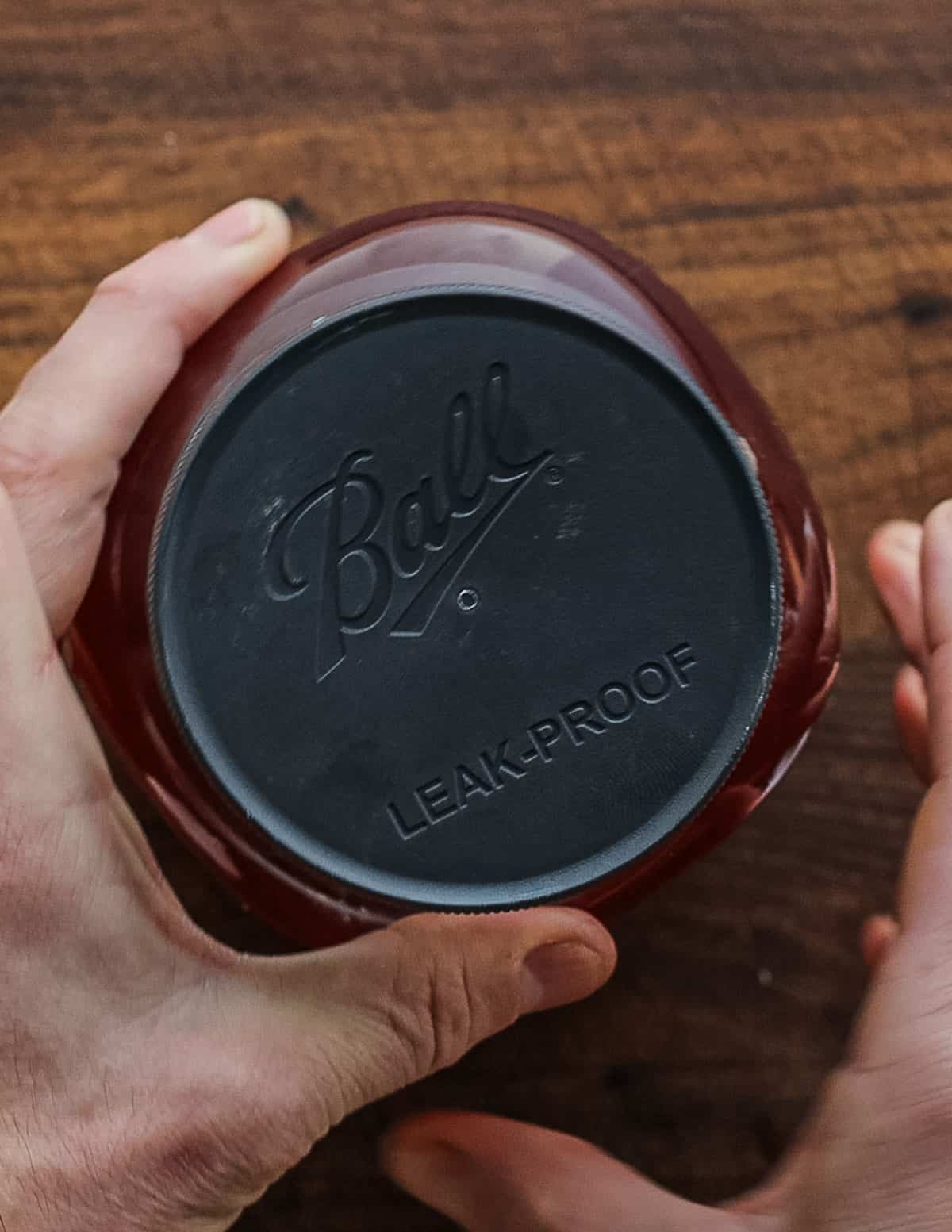
Adding Live Vinegar and Grain Alcohol
The basic recipe is a hybrid of two of my favorites: one from the Art of Fermentation by Sandor Katz, and the other by Rene Redzepi in the Noma Guide to Fermentation. The Sandor Katz recipe is the most basic, and it's a great introduction--you just take fruit and sugar water, and let it ferment. It takes a long time, but it works well.
Rene's recipe speeds the fermentation process by adding live vinegar, along with some grain alcohol to increase ABV, ensuring an acidic result, as if there isn't enough sugar in the beginning product you won't have the amount of alcohol you need to get a good, tart, vinegar.
That being said, I made the recipe for years before I started adding a bit of vodka to it, so know that it's optional. There's recipes for both in this post.
What kind of fruit makes the best vinegar?
Berries, grapes and plums from my experience. The sky is really the limit though: pineapples, mango skins with bits of flesh attached, etc. Here's some of my favorites.
Highbush cranberries
Highbush Cranberries make a brilliant red vinegar. For these I always use the scraps leftover from making a cold juice extraction.
Wild Grapes
Like red wine vinegar, a beautiful nearly purple color, this will taste similarly strong and aggressive, but it's made by your own two hands! Use the scraps leftover from wild grapes after making juice.
Wild Blueberries
Wild blueberries make a deep blue vinegar, and will have a flavor comparable to wild grape, with a very subtle blueberry note.
Aronia Berries
The flesh of aronia berries is tannic, so vinegar is a great way to use them as the finished vinegar won't absorb tannins from the fruit.
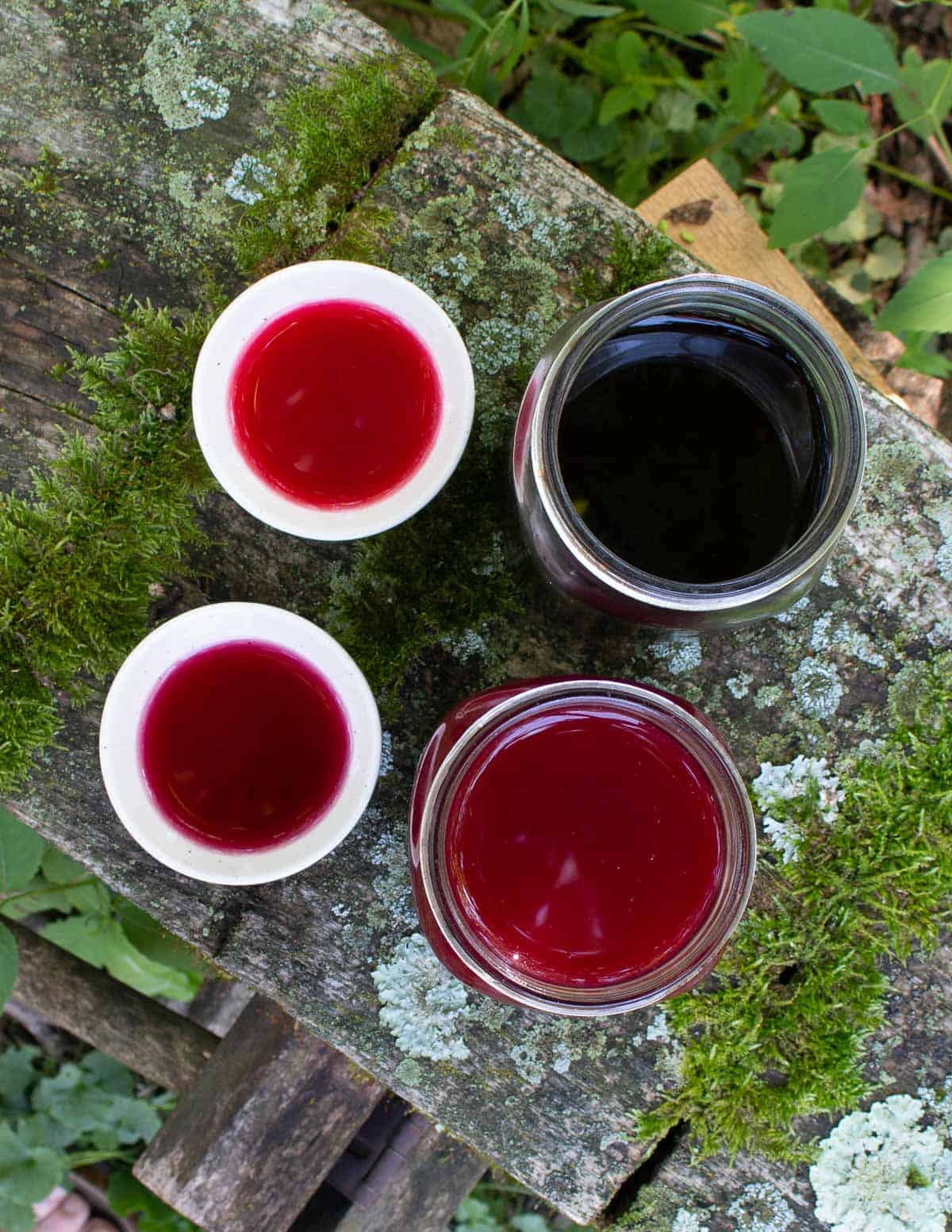
Dealing with fruit flies in vinegar
Since I've posted this, I've gotten a lot of questions regarding the flies.
If you're starting this with fresh fruit during the growing season you may have to trouble shoot some things. Depending on your location, temperature, and conditions, fruit flies can be a small or large headache. Here's some tips.
- Secure the cheesecloth or lid as securely and tightly as possible. Use more layers of cloth than you think you need-at least 3. A single layer of cheesecloth is too porous to prevent flies from getting into the vinegar.
- If after two weeks you notice fruit flies, strain the solids out trough the finest mesh or cheesecloth you have, then wash the container, pour the liquid back in, cover and continue the fermentation process with a new cheesecloth top.
- Start and keep your vinegar outside to avoid having the flies in areas you frequent.
- We are conditioned to think that insects are problematic and potentially dangerous as they can harbor bacteria, but, in the case of vinegar, a fly or two in the liquid can actually help ensure a strong fermentation process as they are covered in natural yeasts. As the pH of the liquid decreases the flies die.
- Freeze your fruit and start the vinegar in the winter.
- While unappealing, fruit flies will not harm the vinegar or make it unsafe to consume.
How to Use Fruit Vinegar
The finished vinegar of dark fruits can be used anywhere you'd use red wine vinegar in general cooking. I often add sugar or maple syrup to it. Here's a few examples of how I use it.
- One of the best things to do with it is to add a sweetener like sugar or maple syrup to taste, and use it to season salads, along with oil.
- You can make it into a syrup by mixing equal parts vinegar and sugar by volume. It's good served warm or cool with game meat.
- Add it to barbecue sauce.
- Seasoning sour soups, especially borcht.
- Use it to make pickled beets and other pickles.
- Use it in a vinaigrette to season marinated vegetables, beans, and other composed salads.
FAQ
Vinegar powder is a chef secret for adding acid to dishes where you may not want additional liquid. To make a small amount to try, put your vinegar mother on a non-stick sheet such as a silpat/silicone mat, and dehydrate at 150 F until crisp. Store in a jar and powder to use it. Scoby mothers can be used similarly. I find it a novelty, personally.
Absolutely! Fresh cooked, or frozen fruit will all work fine Since the vinegar is "backslopped" with living vinegar, there is no need to worry about the success of fermentation if your fruit has been cooked or frozen, which can kill some of the living bacteria on it.
Yes, and it's delicious. You can substitute the juice of any fruit for the water in this recipe. To layer flavor, you can ferment the scraps of fruit in their pressed juice.
Classic Fruit Scrap Vinegar
Ingredients
- 1 cup granulated sugar
- 2 lb fruit scrap from juicing, etc skins, seeds, etc
- 2 Tablespoons living vinegar such as apple cider, or vinegar from a previous batch
- 2 qts water
Sweetening
- 1 cups sugar, honey or maple syrup or to taste
Instructions
Fermentation
- Mix all ingredients, stir well to dissolve the sugar and put into a container, such as a plastic food tub, gallon water jug, bucket, etc.
- Cover the lid with cheesecloth, secure with twine or a rubber band, and leave out at room temperature, stirring as often as you can remember (I use a wooden spoon).
- After 1 month, strain out the solids, then pour the mixture into a half-gallon mason jar. Cover with cheesecloth and continue fermenting for another month or so, until the vinegar is good and strong. When it tastes sour like regular vinegar to you, screw a lid on the jar and store.
- If you forget to strain the solids out after one month, don't worry! It will turn out just fine and will have no effect on the success of the vinegar provided the vinegar is still allowed to respire and has access to air.
- During the process, if you get fruit flies which are annoying but will not harm the finished product refer to my trouble shooting tips in this post.
Sweetening (optional)
- Sweeten the finished vinegar by whisking in honey, maple syrup, or sugar to taste. Start with ½ cup of sweetener per quart of vinegar. Some add a splash of brandy too.
- Heat the sweetened vinegar until hot but not boiling. Cool and store in a container with a tight fitting lid at room temperature for up to two months, or refrigerated for long term storage.
Video
Accelerated Fruit Scrap Vinegar with Alcohol
Ingredients
- 750 grams 3 ¼ cups water
- 172 grams ¾ cup plus 1 Tablespoon previous fruit vinegar, or apple cider vinegar with live cultures
- 184 grams ¾ cup plus 2 Tablespoons 80 proof vodka
- 1 lb 2 packed cups fruit scrap from cooking, juicing, etc
- 50 grams ¼ cup sugar
Instructions
- Combine all ingredients in a 2 quart sized container, cover with cheesecloth, and allow to ferment for 2 weeks at room temperature, stirring as often as you can remember (I use a wooden spoon).
- After two weeks, strain the vinegar and allow to continue fermenting, still covered with cloth, until you like the flavor, a month or two.
- When you're pleased with the flavor, and you can't taste any sweetness in the vinegar anymore, put it into jars and seal, then store in a cool dark place.

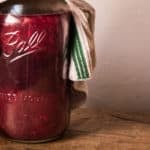
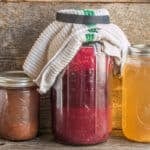
Debra Johnson
I have a question...I just strained off the pineapple from my vinegar and hate to waste it, (it tastes wonderful!) My question is, can I add some sugar and make the strained fruit into a topping for pancakes or a cake or ice cream or make it into a jam? And if so, how long will it keep after bringing it to heat, obviously after heating will have to refrigerate. Thank you kindly,
Alan Bergo
This is actually not a bad idea. Yes you can cook it into a compote, it should be pretty good!
Lindsay
Hi--I made apple vinegar and it is most definitely vinegar, with a PH of 3, and in all ways like any other ACV. But it didn't develop a mother on the top like my plum/aronia version did. It got to vinegar in just a month. Is there any cause for concern? I'd like to bottle before it concentrates more.
Alan Bergo
Hi Lindsay no need to worry at all. I can’t speak to the science of it but I see plenty of variation in mothers between different fruit. Apples have been a little inconsistent for me as far as if I will see a thick wiggly mother-mine usually look wispy like Braggs from the store.
This year I made crabapple vinegar and elderberry. The crab apple was done faster and was cloudy with strands. The elderberry quickly made a rubbery, thick mother that covered the entire rim of the jar. They’re so alien looking.
One of the best parts about this is that as long as it has air during the fermentation you’re basically guaranteed vinegar. I’ve done a lot of comparing pH levels by taste over the years and generally speaking, I’ve found that if it even tastes slightly sour it’s in the safe zone, say around 3.2-3.5. I’ve always assumed variation would come from fruits having different amounts of natural sugar which affects the alcohol. The alcohol in turn affects the concentration of acetic acid in the finished vinegar.
Interestingly, once the vinegar gets to a stable acidity it becomes difficult to bring the pH down even further. For example, if you added, say, 1 tsp of vinegar to a quart of liquid and it went from 3.7-3.5 then added a second teaspoon it may only go down from 3.5-3.45, if that makes any sense.
TLDR: Once homemade vinegar starts to taste tart you’re basically guaranteed a safe, usable product.
ev
I made apple scraps vinegar (local to Cuenca Ecuador, free of pesticides, tiny) about 3-4 months ago. When might I expect a scoby to develop? Thank you kindly.
Alan Bergo
You should've seen a mother within a week or two.
Geoff
Hi there..... one quick question .... if replacing all the water with fruit juice would you not add the additional sugar ? As there is a lot of sugar in the fruit juice anyway ? Thanks !
Alan Bergo
That should be fine, the catch is that fruit juices vary in sugar content. For example, apple juice is much sweeter than elderberry or aronia, which have next to none. A little more is ok, but a little less can mess with your end pH. Use a little math and compare the sugar content of the juice you’d like to use with the the proportions of this recipe for the best result. Then you can adjust with a little extra sugar.
Mike Moranz
Wow. Very popular. Raspberry pulp from jelly making used with Kombucha mother and a bit of starter. I read that the Kombucha bacteria would not ferment fruit but it surely does, and the result is less intense. Very dense raspberry flavor and not overly vinegary. I then pasteurized, bottled with a hot pepper and into the fridge.
Thanks to you my countertops have less and less space.
Alan Bergo
Oh yeah. Raspberry vinegar gets some shade from my peers that cooked in the 90’s and early 2000’s but it’s great. Try infusing some with fresh raspberries and sweetening it with maple for an incredible salad vin. I have a method for that here.
Roman Wolf
Hi Alan, I made a sour cherry vinegar using whole cherries that were going to go to waste and I was about to go out of town (running short on time) so I threw them in whole. It had always been my understanding that unless crushed or punctured, cherry pits used in vinegar would not leach cyanide. However, after reading your post on utilizing stone fruit pits for almond flavoring and reading through some of the comments, I am left with pause. Do you have any personal experience with using cherry pits in vinegar that you can speak on or do you think it is best not to consume? The vinegar formed a beautiful mother and it smells terrific so I am hoping it is able to be salvaged, but perhaps I can use for it in an art project as a dye if I don’t come across any firsthand accounts of its safety, and take this as a lesson to choose a better day to pick my cherries next year!
Alan Bergo
I have only used them dried and cracked. Sometimes I can speculate with other recipes but for this using dried and cracked is all I can recommend you do. It *may* be ok if you haven’t cracked them and exposed the kernels, but I haven’t done it like that, so I can’t tell you it’s ok to.
Coco
Thank you so much for this recipe. I’m making quince scrap vinegar for the second year and I’d like to be able to adapt based on my specific amounts of scraps more easily and for the life of me cannot find a water/scrap to sugar ratio anywhere online. I realize that quince is likely different than a higher sugar fruit, but none the less figure if anyone knows this information it would be you.
Alan Bergo
Just follow the recipe it should work fine.
Carmel Bowman
Ever tried pawpaw vinegar? I had an abundance of pawpaws this year and ended up throwing many to the critters in the woods because they were over-ripe. If you HAVE used them, did you get the seeds out first? I would love to find a recipe where I don't have to get the seeds out.
Alan Bergo
I tried some last week that was quite bitter. I would make it, but I would remove the seeds and skin, and use only very ripe paw paws as just one bitter one could ruin the whole batch.
Linda Benton
This recipe is fantastic! I have made this vinegar out of strawberry scraps, pear scraps, grape scraps, and one out of a few leftover misshapen quince. The recipe makes delicious vinegar and when friends and family have tried the vinegars, they want the recipe! It is easy enough to make adjustments for the seasons and the temperatures. I also have adjusted the fermentation time depending on the use of the vinegar, and whether I prefer it to be mild and sweet or plenty sour and tangy. Thank you so much for sharing!
Alan Bergo
Hey thanks Linda. Just finished making some elderberry vinegar last week.
Linda Benton
I wondered if you had any ideas for making shrubs with the fruit scrap vinegars? They are so delicious, and I would like to try some mocktails.
Alan Bergo
Yes, if you sweeten the vinegar as I describe and heat it to stop the fermentation it makes an excellent shrub.
Hannah Lashbrook
Hi! I just made your wild crab apple jelly recipe and wanted to use the leftover crab apple pulp to make some vinegar - would this recipe work for that?
Thank you! Hannah
Alan Bergo
Hi Hannah. Thanks for reminding me of this as I'd been meaning to make a note of it. Of all the fruit I've made this with only a few have disappointed me. Unfortunately crabapples with tart / astringent skins seem to really transfer that flavor into vinegar. Nannyberries are the only other fruit I haven't had a good result from. You could use some of the apple pulp, but I wouldn't use more than 25% or 4 oz for the 2 lbs of fruit scraps the recipe calls for, or whatever size batch you're making. That said, crab apples vary drastically and some (chestnut crabs for example) would be fine, as would others that aren't very astringent. Another thing to take into consideration is how long the skins sit with the sugar at the beginning of fermentation. If I had a bunch of cooked crab apple scrap I was determined to use in vinegar, I'd probably cut down the initial fermentation to a day or two and replace the fruit with scrap from grapes, plums, blueberries, sweet apples, etc. One good thing about vinegar is it's cheap to make and experiment with.
Cathy K
I have tried several other scrap vinegar recipes for several years without success. I used your recipe and had 100% success this year with chokecherry, elderberry, plum, and peach vinegars and all developed the mother. I am grateful and excited to have had success with my vinegar venture this year. Thank you for your recipe and knowledge that you share. The other recipes I have tried stated to "take a PH reading to ensure the vinegar has the correct PH. It should be at least 4.0 and preferably 3.0 to 3.5. If the PH is above 4.5 then the fermentation process was not successful and the mixture is not safe to consume. Discard it if the PH is above 4.5. If the PH is lower than 3.0 that is ok, however it may be unpalatable due to being so acidic." Do you recommend testing the PH and if you do, what PH do you recommend? I did test my chokecherry and elderberry. They test at a 3.0-2.5. My peach and plum still have another week of fermenting before they are ready.
Alan Bergo
Hi Cathy. I never test the pH of vinegars. I just taste it. If it tastes good and sour, great. Anyone who judges a vinegar for being too sour is silly imo. It’s vinegar and it’s supposed to be tart. Most people complain their homemade vinegars aren’t tart enough. I did a lot of experimenting with tasting pickles to figure out if I could simply taste them to see if they were shelf stable. If something tastes tart to me it was always under 3.5, typically lower. I understand that’s a bit imprecise though.
Cindy
Hi there I made the recipe for the vinegar 2 weeks ago but I didn't notice any bubbling at any point. What should I do with it at thus point?my fruit is still in the jar
Thanks
Alan Bergo
Hello Cindy. Make sure the jar is open an covered with cheesecloth as vinegar needs to breathe. If there’s no bubbling, add a splash of living apple cider vinegar from the store. It would also be useful to know what fruit you used.
Elizabeth
Hey Alan, I'd like to make this using wild grape scraps without adding any starter vinegar (I will in future batches, but I want it to be pure and I don't want to cheat with a store bought vinegar.) Any suggestions? Is it still okay to warm the grapes as you showed in your youtube video, or will that ruin too much of the natural bacteria and yeasts on the grapes? Love your site, thanks for all you do!
Alan Bergo
Hey this will work fine, you just need to have some kind of wild yeast that hasn’t been killed by heat. Save a handful of raw grapes and toss them in, or a slice of ginger and a crabapple, etc. I’m here if you have more questions.
Elizabeth Siebenaler
Thanks! Any tips for preventing kahm yeast? I've had trouble with it in the past.
Keith J Barry
"Strain the solids out of the vinegar after a week."
"If after two weeks you notice fruit flies, strain the solids out "
"3. After 1 month, strain out the solids,"
Between an week and a month?
What's a good way to know how long before straining?
Also, the instruction to stir is left out of your Classic Recipe, but included in the Accelerated.
I'm making quince vinegar, and I didn't stir. Luckily I saw only a tiny dot of fuzzy mold on an exposed seed. Perhaps due to the lack of sugar in the quince?
There is a thick whitish layer of gel, like rubbery ice, surrounding and suspending the top layer of fruit.
How to know when to strain?
How to keep the scoby alive while using the finished product?
Thanks!
Alan Bergo
Sorry if that's unclear. This is one of those recipes where there's so many different ways it can be made. Leave the solids in the vinegar for 2 weeks, ideally. Once the mother has formed it will be difficult for it to mold, just strain it out and discard. The mother has infected the whole batch of vinegar and the physical mass of it isn't important anymore-don't feel bad about straining it. You keep the mother in the vinegar alive by not cooking it. I'm here to help out with other questions if you need help.
Keith Ikeda-Barry
Following up; it worked out just as you said, Alan, thank you.
We used quince scraps and ended up with a fragrant, golden vinegar.
We followed your extra steps and sweetened a portion of it for dressings. Mixed with soda water, it also makes a really nice sparkling shrub.
We're storing the mother immersed in the dregs of the vinegar to help start the next batch, maybe with all these winter orange peels.
Thanks again for your recipes and the extra help.
Alan Bergo
Hey great I'm so glad it worked for you. I've never made it with quince personally. Yes, once it's seasoned it can be used with all kinds of things. A little sugar really helps the individual fruit character come out.
Dean Sherwood
I finally got around to watching this video. I've been making scrap vinegars for a few years, inspired by Dwight Zietlow and Rachel Mifsud (both mutual acquaintances of Sam Thayer). Recently it occurred to me that malt liquor does not contain hops, and therefore would be a true malt vinegar. A 40 oz. Colt 45 makes a lot of vinegar cheap enough to use as a cleaning fluid and good enough to use anywhere else. It also makes it quickly. It's not foraging, but it works.
Tom
Thank you for your last reply.
You wrote when you sweet the vinegar you also have to heat it up. But then you can't store it for long. How come?
Alan Bergo
You can store it for as long as you like.
Tom
Last time it tried to make the bird cake, but unfortunately my cherries weren't dry enough and got a sticky mess unable to take the grinder seeds out. Now I wonder if I could infuse this vinegar with it, when heating it up in the last step, or infuse it already for a couple of weeks before that or even make ice cream from it. Any suggestions?
Alan Bergo
Hi Tom, so you can actually take the cherries and continue to dry them until they're brittle and bone dry. They will lose some flavor though. Unfortunately the juice is an important part of making the vinegar here, so I wouldn't use dried fruit.
Diane McGrenere
I made fruit scrape vinegar last year from the wild grapes I processed for jelly. Very easy and very good.
I am making more this year and will try the sweetened version but will also like to try making some shrub - recipes for which I have seen on line from other sites.
Do you have a shrub recipe?
Can you water bath the sweetened vinegar-or shrub- for longer storing?
Thanks - love your sites and easy directions and information
Alan Bergo
Hi Diane. I do have a basic shrub format you can take a look at here. Yes you can water bath the sweetened version, it will stop it from fermenting too.
Sara
I accidentally added twice the amount of sugar! I see it is recommended to keep about the same proportions. Recommended course of action?
Alan Bergo
Hi Sara. You can dilute it with fruit juice or some similar liquid. Or roll with it and hope for the best. It'll probably work fine.
Tom
Heyho,
My vinegar developed a cap, something similar like a kombucha scoby on top. Is it good or bad? Should I leave it, toss it, eat it?
Best
Tom
Alan Bergo
This is a vinegar mother and is proof you’ve succeeded.
Tom
Hurray!
But now, what to do with it?
Does it mean the other batch is not good?
Alan Bergo
They're both probably good. I've never had one go bad with this recipe. Different fruits can mature into vinegar at different rates, and have slightly different characteristics.
Eva Huey
I have 2 batches going of wild grape scraps that is 6 weeks old. I strained fruit a few weeks ago and left to ferment. I have slug of mother in both batches. What do I do with them. Can I keep it in or should it be strained out?
Alan Bergo
You can keep it in, that means the vinegar has worked.
Mandy
Can I use plums that still have the pit in them? Or do I need to remove the pit? I have an abundance of wild overly ripe plums. I’m thinking this is a great use for them!
Alan Bergo
Yes you can.
Mandy
Thanks! I have one more question - I ended up using too small of a container. So my ratio of fruit, sugar and water is wrong. How important is it to keep to those ratios? I ended up doing 6lbs plums, 3qts water, 1.5C sugar all in a 5 gallon container (no vinegar just yet). Is this workable still? Or will the ferment go off? Thanks again. I really appreciate the help 🙂
Alan Bergo
You want to keep roughly the same proportions. This should work.
Tim
I've made vinegar from raspberries before- once. Most times I try to make it it gets overgrown with kahm yeast. Most of the time I try to make sauerkraut, the same thing happens. I've gotten so frustrated that I stopped trying to make ferments. I don't really want my ferments tasting like bread.
Alan Bergo
The reviews of this recipe speak for themselves. If you don’t like worrying about kahm yeast you have to try my raspberry vinegar, it’s a maceration so there’s no worry of contamination.
Katie Goin
Hi Alan , I made vinegar with wild blueberry scraps .. it’s been in the container for 4 days now and I’m already seeing bits of white mold forming on the surface. Do I skim that off ? Toss the whole lot ?
Thank you ! 🌱🍄❤️
Alan Bergo
Hey Katie. Without seeing images, the first things I would ask are: is it able to breathe and covered with cheesecloth? Is there visible fermentetion? The fermentation should start within a few days. If the fruit was cooked, remember it will kill natural yeast and you are reliant on the yeast in the mother you added, if you use an old vinegar you made, it may be a little tired.
It could be mold, or it could be kahm yeast. If it was me I’d pick it off, add a splash of vinegar Im sure has active mother, then watch and wait. When you see the fermentation starting the process to vinegar will be unstoppable.
Alexandra
Hi Alan,
This past fall I made wild grapes fruit scrap vinegar using this recipe but it grew what looked like kham yeast. So I decided to try an experiment and boiled it and put it into a new jar with a bit more live vinegar and sealed it with a silicone lid with a little air vent on it. This sealing it might have been a mistake? But here’s what’s odd- it very quickly grew a thick jelly like scoby/mother on top of it and sat in my pantry for a couple of months like this. But it never actually bubbled or seemed to ferment at any point, the scoby just got thicker and thicker. I kept it with the self venting silicone lid on it the whole time. Today, I strained out the liquid into a bottle and put the scoby/mother in the fridge to maybe use later. But the “vinegar” basically smells like grape juice, not vinegar to me. I haven’t tasted it yet. The fact that it didn’t ferment and that it doesn’t smell super vinegary makes me wonder if things went right, but perhaps it fermented already while it was growing the kham yeast…and the gorgeous gelatinous scoby/mother on top also seems like a good sign so I hate to ditch it. Any idea what I have made and if it’s likely safe to consume?
Alan Bergo
HI Alexandra. Sorry it took me a bit to get to this. It's safe to consume but I can't speak to what happened there. Kahm yeast can be a pain. If you haven't, I recommend trying the alcohol method I include in this post as it really seems to halt the kahm in its tracks.